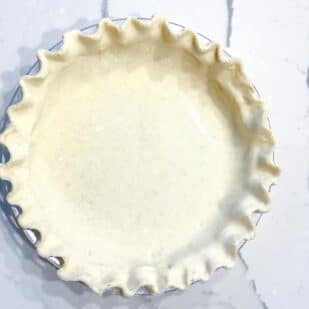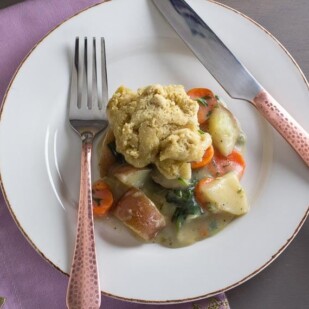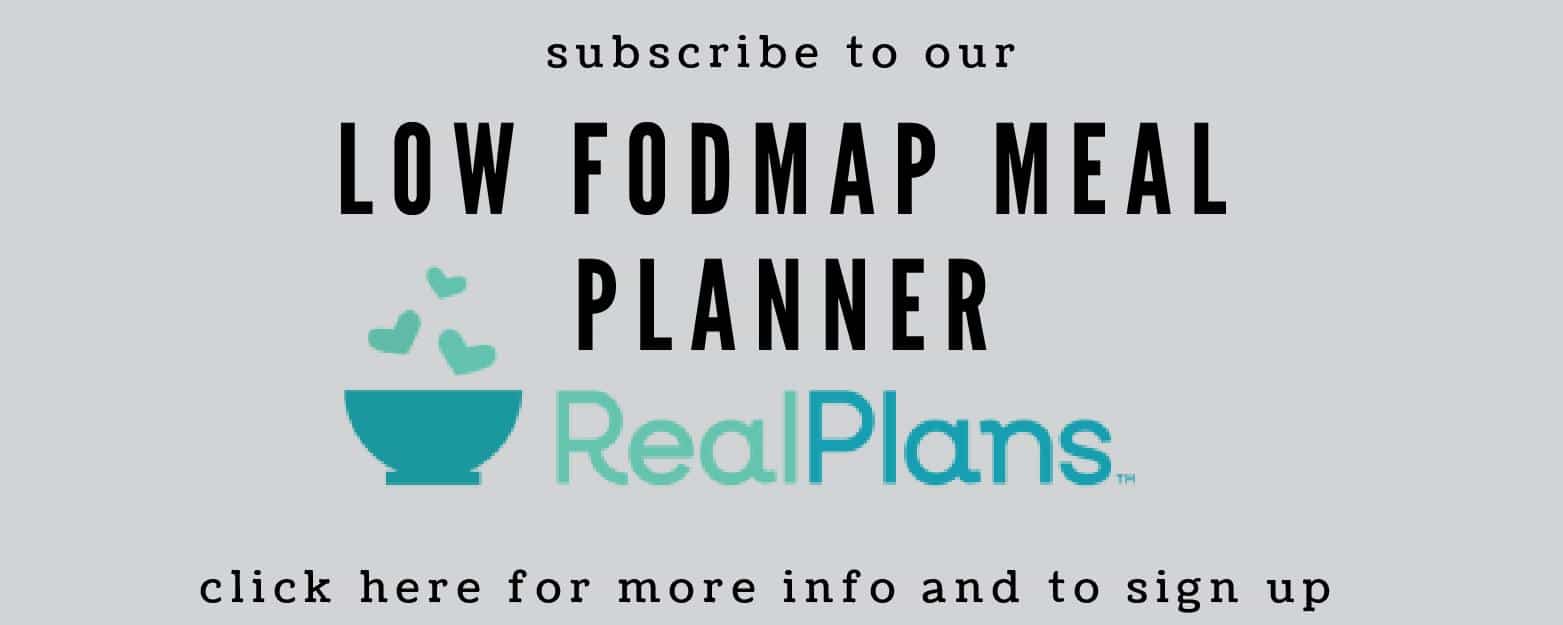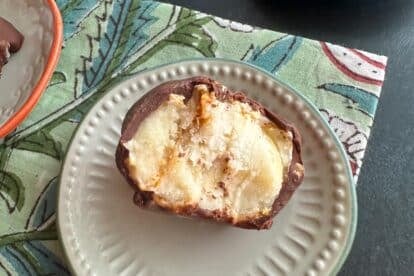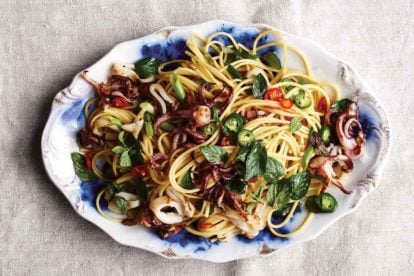What is Low FODMAP Fresh Blueberry Pie? A pie that is so blueberry-y that it is practically incomprehensible. It is made by cooking blueberries on top of the stove until they are jammy, and then folding in fresh blueberries and the whole shebang is poured into a flaky, pre-baked crust. This is our Low FODMAP Cream Cheese Pie Crust!
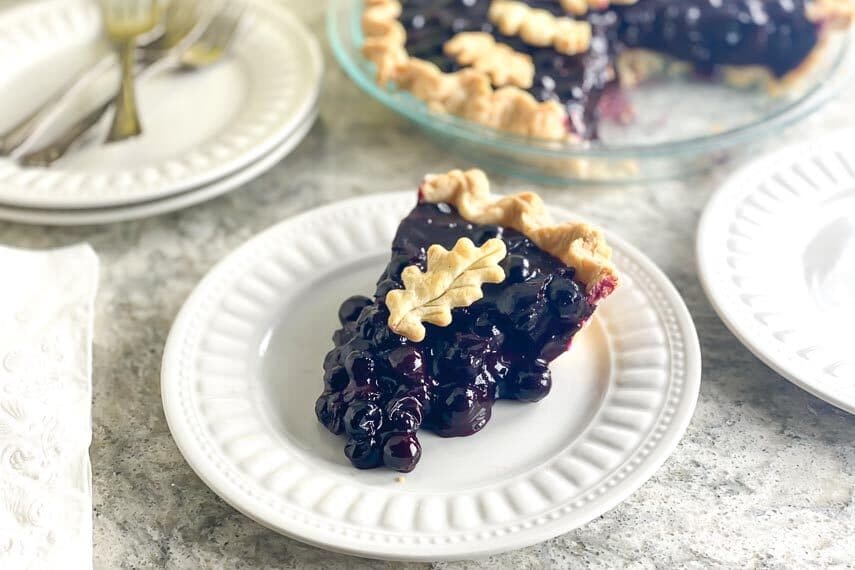
Blue-Ribbon Winning Pies
Years ago I judged a Pillsbury Pie Contest. We had dozens and dozens of pies entered – I think there were slightly over 40 – and we judges had to taste them all. I know; it’s a hard job but someone has to do it!
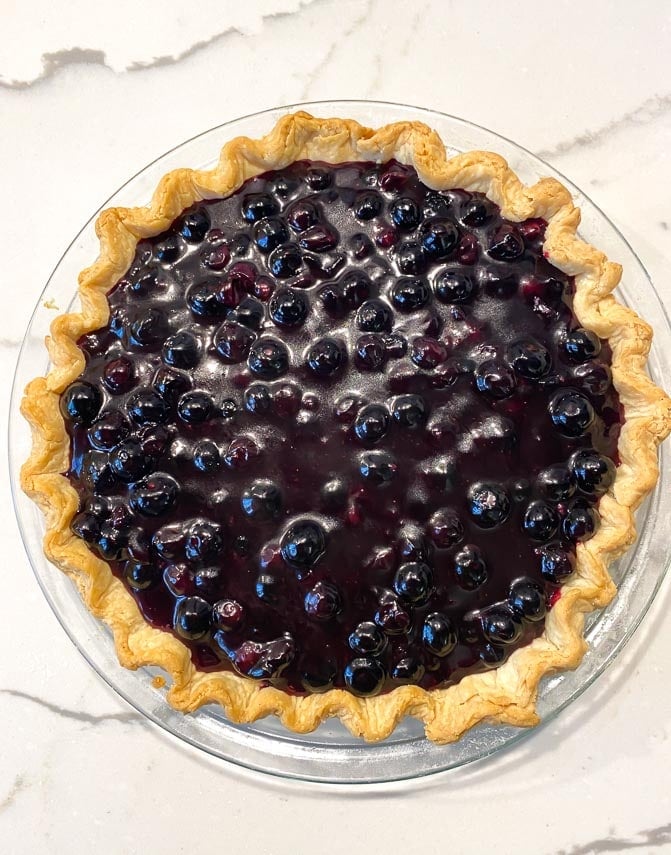
In all seriousness, this kind of judging is not easy. There were apple pies (many) and peach pies (ditto) and savory pies (a few) and chocolate mousse pies and peanut butter pies…you name it. And in the midst of all of this taste bud numbing sampling there was a clear stand-out. Our winner that day was a fresh blueberry pie.
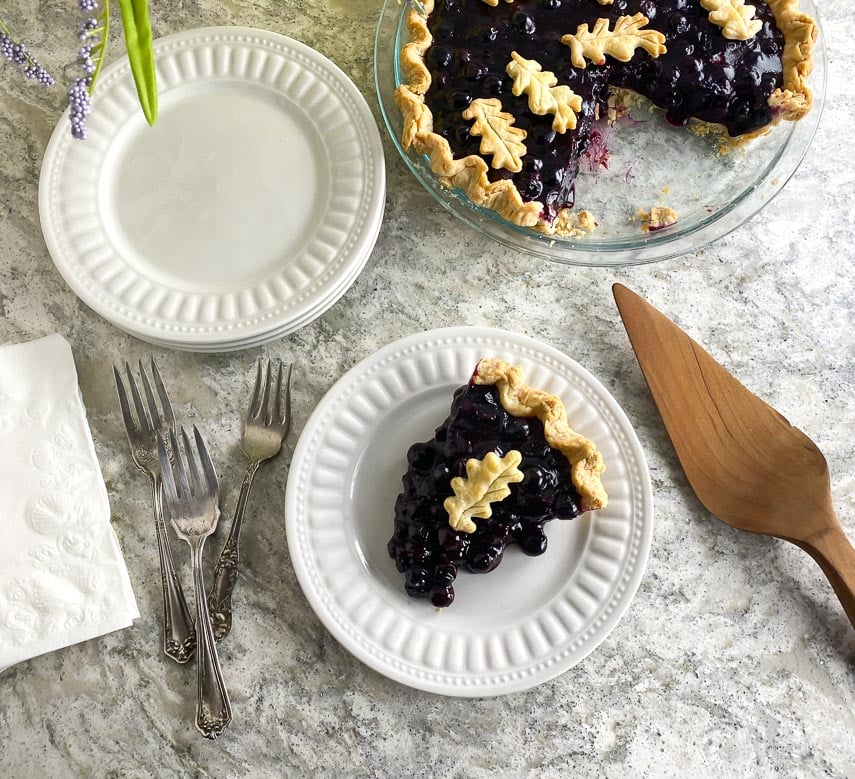
One bite and it was like the sun came out and angels sang. The flavor was so fresh, so true, so powerful that it was not to be denied. This recipe has been years in the making, but I think I did an honorable job duplicating that prize-winning pie.
And, this version is low FODMAP, gluten-free and lactose-free!
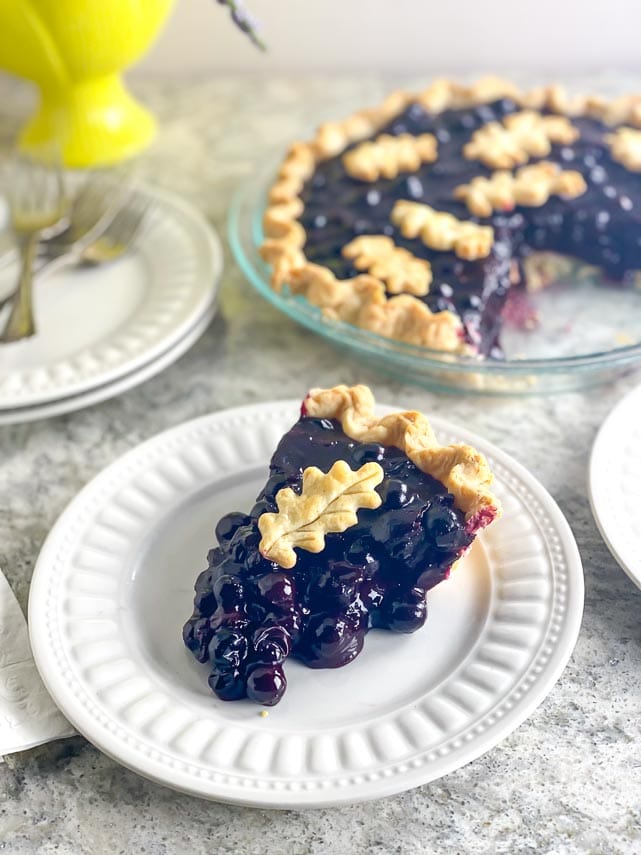
Blueberries have been lab tested by both Monash University and FODMAP Friendly. FODMAP Friendly gives them a “Pass” at 1 cup or 150 g, with a maximum serve of 3 cups, or 450 g. In initial lab tests, Monash stated that a Green Light low FODMAP serving was a heaping ¼ cup or 40 g. In those initial tests the fruit jumped to Moderate FODMAP levels quickly at ⅓ cup or 50 g (for GOS). Blueberries were re-tested in late 2022 and now are considered low FODMAP at 1 cup or 125 g. Fine print states that they remain low FODMAP up to 500 g, which is the highest amount tested, not necessarily the highest amount that would remain low FODMAP. Eat to your tolerance.
In initial lab tests, Monash found blueberries to contain GOS, while FODMAP Friendly lab tests detected fructose and no GOS. All of this lab testing, which is all accurate and reflects what was tested at the time, tells us that there is a lot of variability among fresh blueberries. No one can tell you what FODMAP content your blueberries have at home right now, or at the store next week. Simply use the app entries as guides, and eat to your tolerances.
I love blueberry pie. It was my favorite of all the pies my Nana made. We have a classic two-crusted baked Blueberry Pie for you, if you are looking for one.
This pie combines cooked and fresh blueberries. You start with sugar and some cornstarch for thickening and part of the berries cooked together in a saucepan. The resulting jammy mixture is enriched with a little butter, sparked with lemon juice and then fresh berries are folded in. Hence, Fresh Blueberry Pie. This warm mixture is scraped into a pre-baked crust and that’s it!
I have made this pie many times and it works beautifully with cornstarch. If you want to try another thickener you can, but I cannot guarantee success and do not recommend it. If you do try it with another thickener and have a great outcome, by all means let me know.
I am thrilled to tell you that, yes, we have a fabulous all-butter pie crust that has been met with resounding success. And the news only gets better. For this recipe I developed a gluten-free lactose-free Cream Cheese Pie Crust. And it is delectable. Flaky, a little tangy, rich and might be my new favorite.
My good friend Rose Levy Beranbaum will be known to you if you are a baker. She is the baker’s baker and the muse for many. Of the thousands of recipes that she has developed, she has said that her cream cheese pie crust is her best and most important.
I know that could be a recipe for disaster, trying to “improve” upon such a thing, but I don’t look at this as an improvement. It is a variation that allows us FODMAPers to partake. And/or, if someone is looking for a gluten-free version that just happens to be lactose-free, here it is.
Note that you do need to make the par-baked Cream Cheese Pie Crust first. Then you will make the no-bake filling.
The leaves are made from leftover dough, after it has been fitted into the pan. They are completely optional. Simply roll out the leftover dough, cut with leaf-shaped cookie cutters, and make little veins with the back of a knife. Brush with a little heavy cream.
Bake on a parchment lined pan, separate from the pie, as they will bake fast. Check at 6 minutes. Cool and simply place on top of pie right before serving.
Ingredients
Nothing fancy here. Get the freshest blueberries you can find!
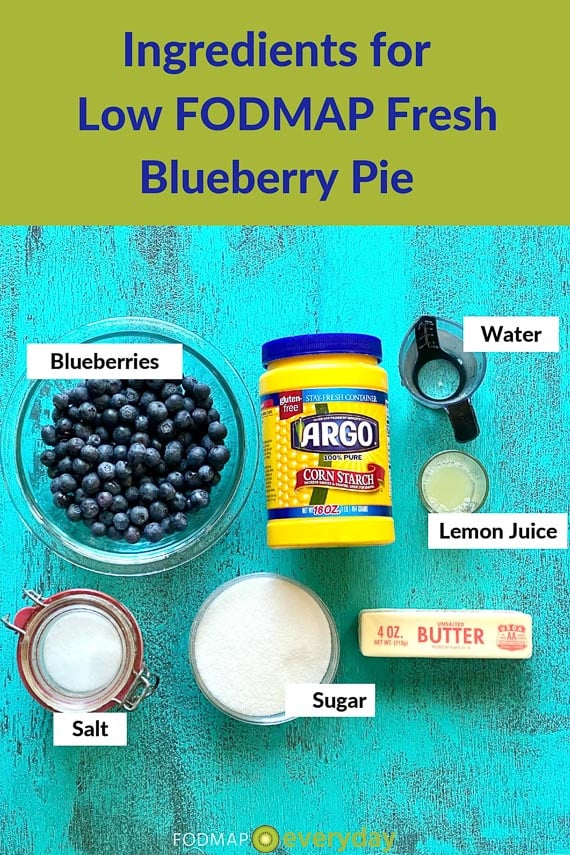
While fresh squeezed lemon juice is always best, I have occasionally resorted to the Minute Made Frozen 100% Lemon Juice, which I actually like a lot, however, PLEASE do not use bottled of any kind. They are all quite substandard.
How To Make Fresh Blueberry Pie
Coat a 9-inch (23 cm) ovenproof glass pie plate with nonstick spray.
Remove Cream Cheese Pie Crust from refrigerator, unwrap and work it a bit with your hands until pliable. If it is too hard or crumbly, allow it to soften for a few minutes at room temperature.
Lightly dust your work surface with low FODMAP gluten-free all-purpose flour and roll out the dough to a diameter of about 12-inches (30.5 cm) around.
On this day I was using my thin wooden rolling pin, which I love.
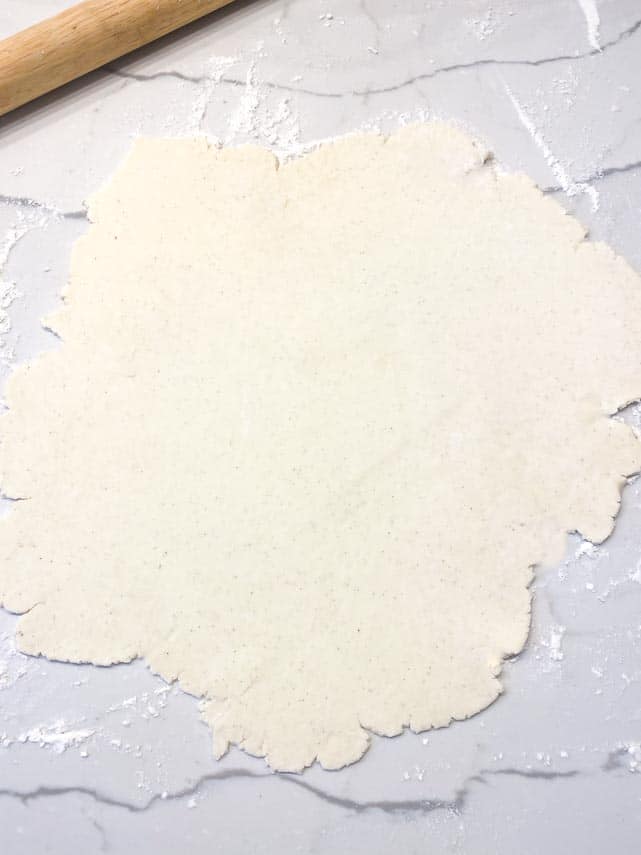
Fit into the prepared pie plate, trim and flute the edges. I like to use a scissors to trim the dough.
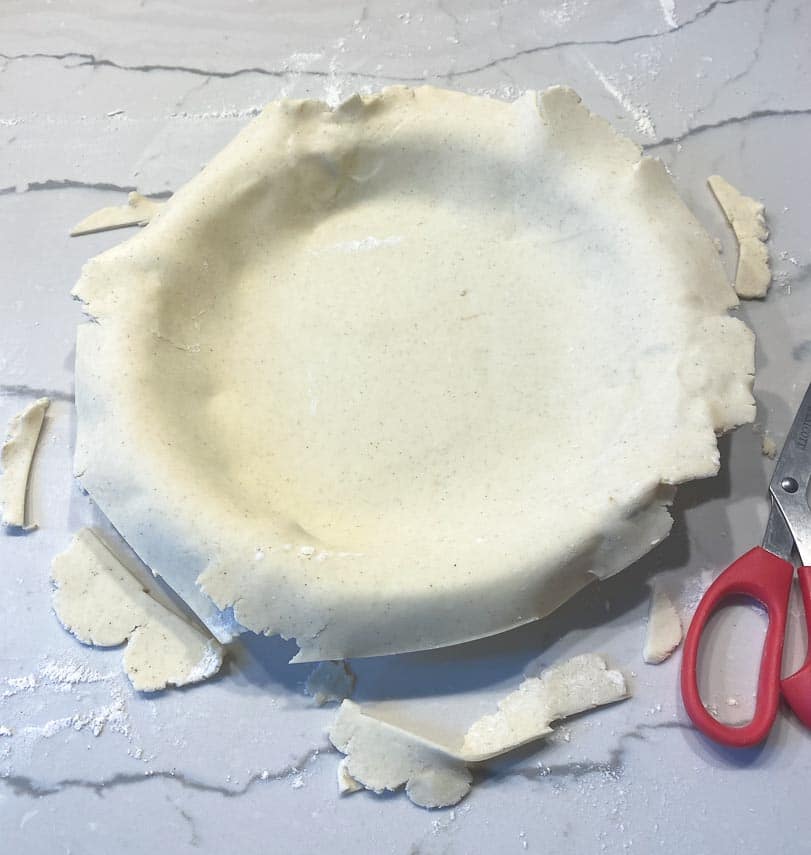
Here you can see I made a simple fluted edge. Refrigerate the crust for 30 minutes.
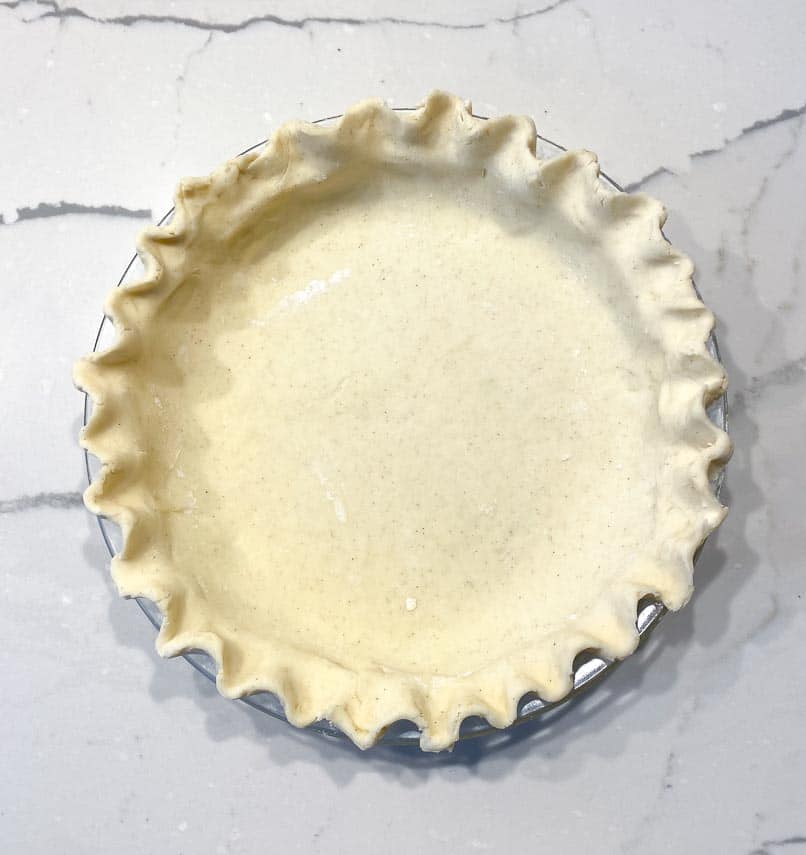
If you want to make the optional leaves, simply roll out any excess dough, cut with leaf-shaped cookie cutters, and make little veins with the back of a knife. Place on a parchment lined pan, separate from the pie. Brush with a little cream.
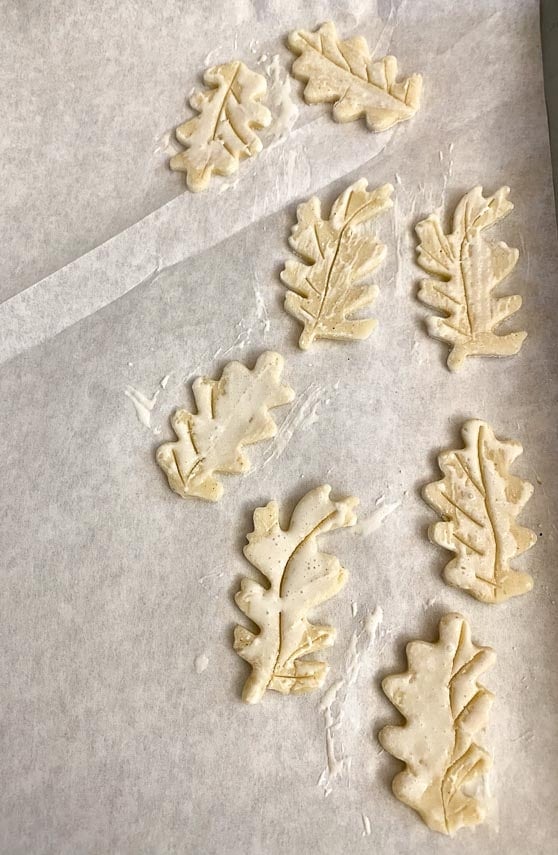
Position rack in lowest rack of oven for pie. (If also baking leaves, place another rack high up in the oven). Preheat oven to 425°F (220°C). Line pie with foil, parchment or coffee filters and pie weights. I love using coffee filters because they are round and fit inside a round pie so well.
You can see that here I used a “pie chain”. They are heavy and being one strand are very convenient.
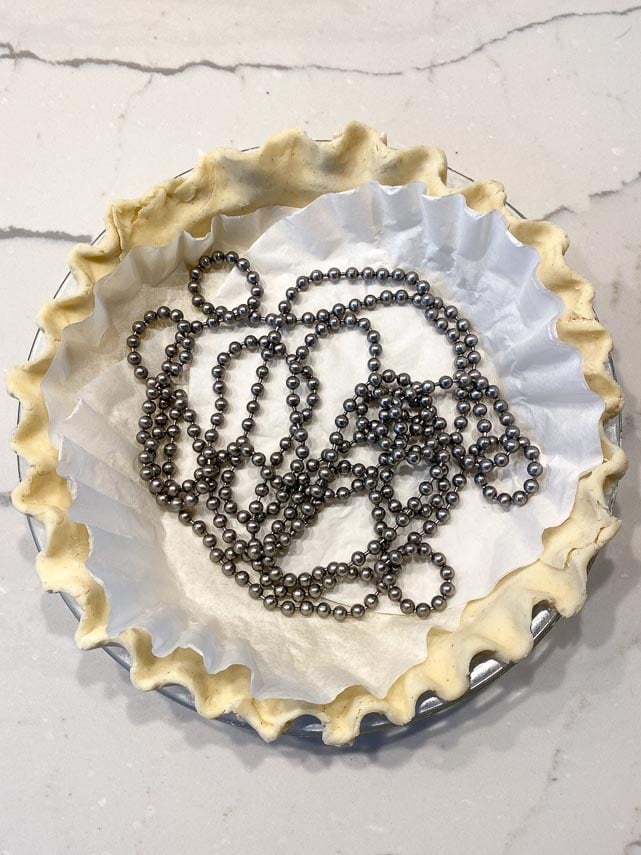
Bake for about 20 to 25 minutes or until the crust is beginning to set and color. Remove the pie weights and whatever you used to hold them and continue to bake until crust is fully baked and golden, about 5 minutes longer. Cool on wire rack.
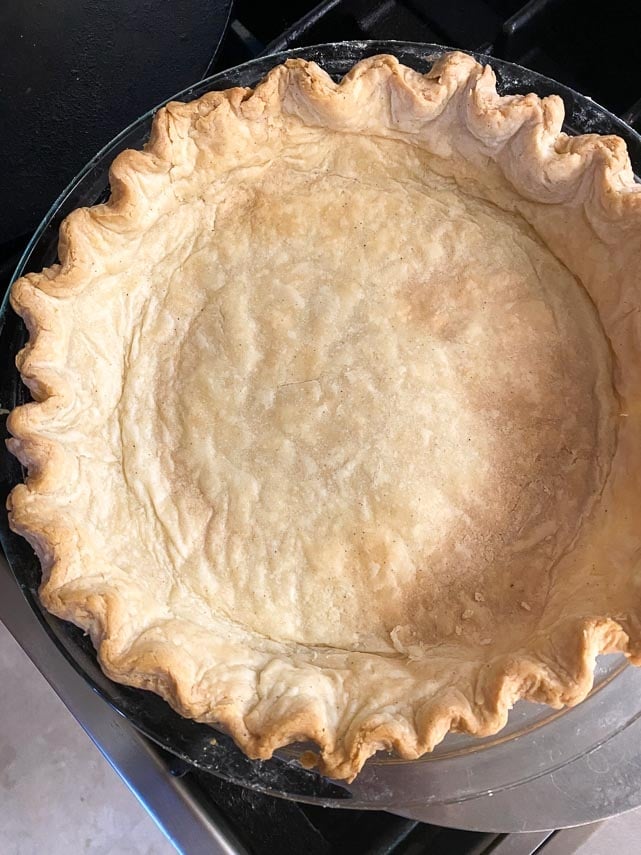
For the leaves, bake on high rack along with pie crust. Check then at 5 minutes as they will bake fast. Bake until light golden brown. Cool on rack and save for later.
Whisk the sugar, cornstarch and salt together in a non-reactive medium-sized saucepan.
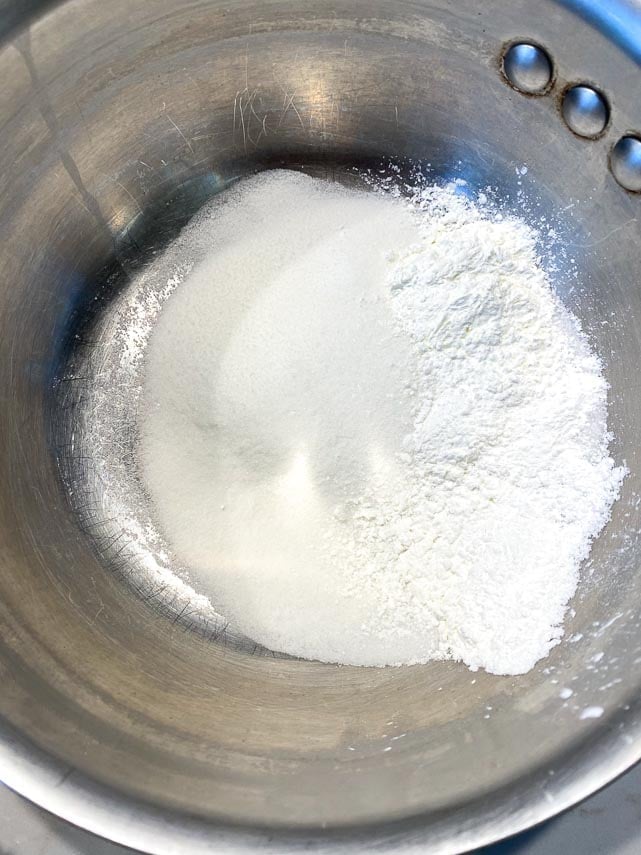
Whisk in the water.
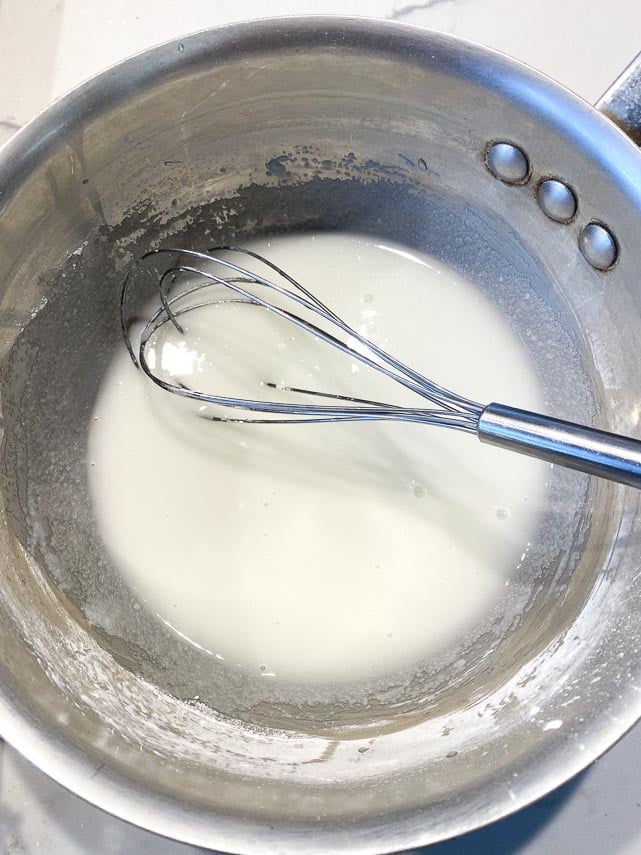
Then fold in 3 cups (444 g) of the blueberries until coated.
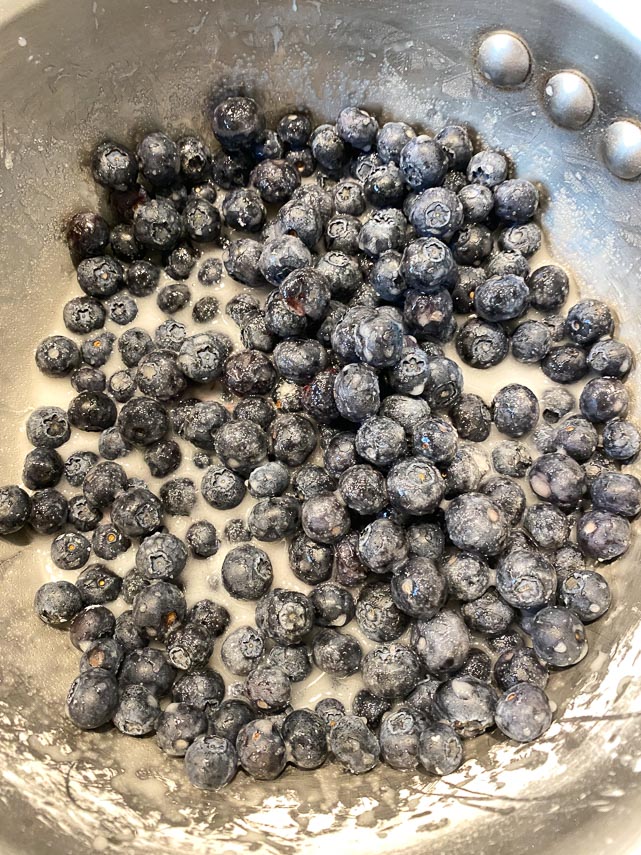
Cook over medium heat, stirring often, until mixture comes to a boil then adjust heat and vigorously simmer for 2 minutes, stirring frequently. The berries should be thick, glossy and jammy.
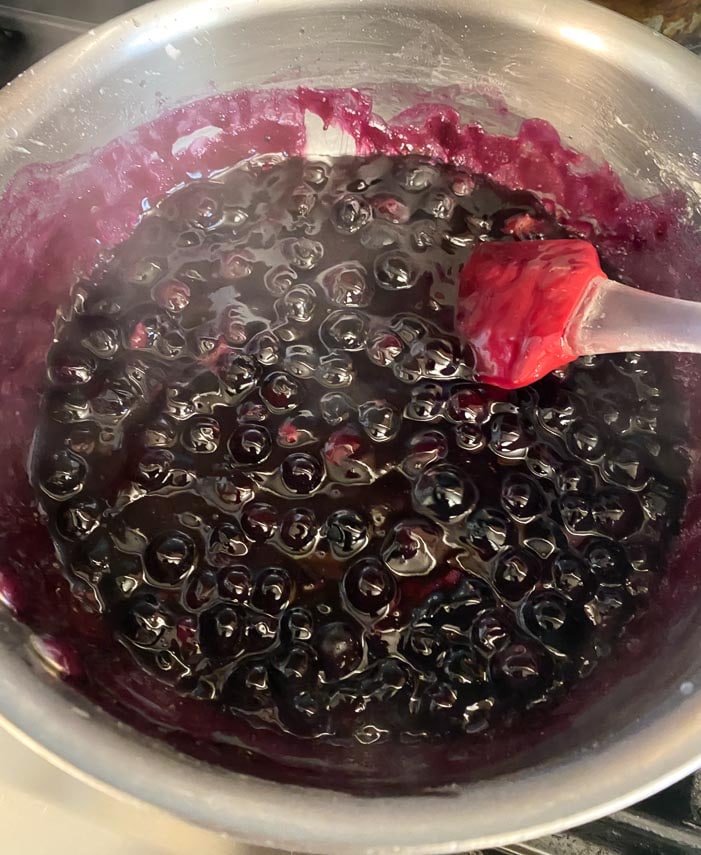
Remove from heat and immediately stir in the butter until it melts, then stir in the lemon juice and remaining 2 cups (296 g) blueberries until everything is combined well.
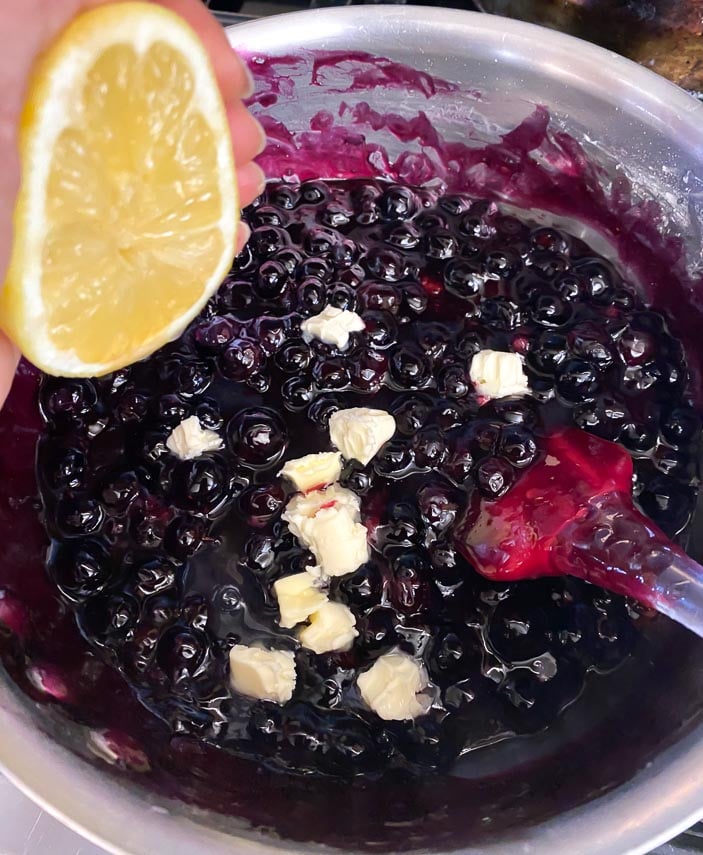
Scrape into cooled pie shell and allow to cool to room temperature, then refrigerate until firm, about 4 hours. Right before serving place the optional leaves here and there on top. You can serve the pie chilled or at room temperature. I don’t usually serve this pie warm, but Robin ate it warm with vanilla ice cream and said it was fantastic.
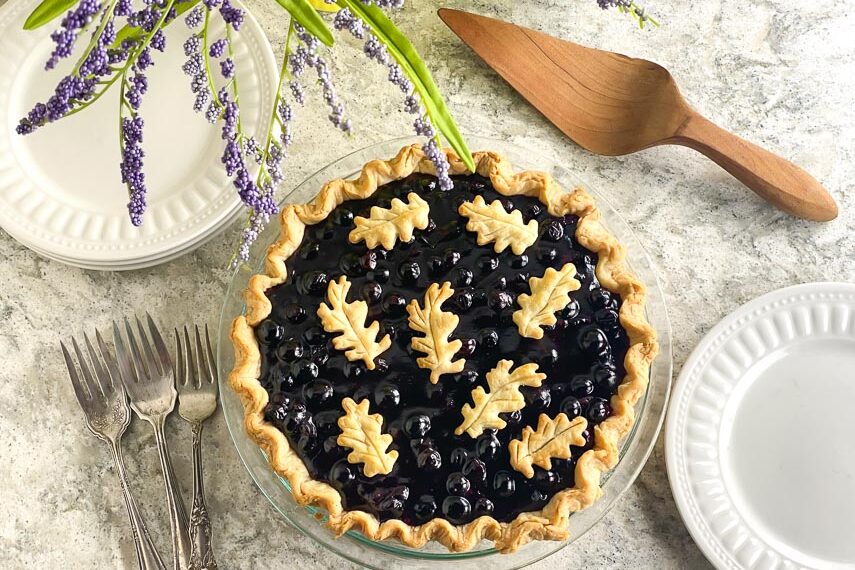
FODMAP Information
Our recipes are based on Monash University and FODMAP Friendly science.
- Butter: Both Monash University and FODMAP Friendly have lab tested butter. Monash states that a low FODMAP Green Light portion is 1 tablespoon or 19 g and also states that “butter is high in fat and does not contain carbohydrates (FODMAPs)”. FODMAP Friendly gives it a “Pass” at 1 tablespoon or 19 g. Both recommended serving sizes are presented as part of healthy eating guidelines, not as maximum FODMAP serving size. Fat can affect guy motility and trigger IBS symptoms in some people. Eat to your tolerance.
- Blueberries: Blueberries have been lab tested by both Monash University and FODMAP Friendly. FODMAP Friendly gives them a “Pass” at 1 cup or 150 g, with a maximum serve of 3 cups, or 450 g. In initial lab tests, Monash stated that a Green Light low FODMAP serving was a heaping ¼ cup or 40 g. In those initial tests the fruit jumped to Moderate FODMAP levels quickly at ⅓ cup or 50 g (for GOS). Blueberries were re-tested in late 2022 and now are considered low FODMAP at 1 cup or 125 g. Fine print states that they remain low FODMAP up to 500 g, which is the highest amount tested, not necessarily the highest amount that would remain low FODMAP. Eat to your tolerance.
- Lactose-Free Dairy: Lactose-free dairy, such as lactose-free milk or lactose-free cream cheese, has lactase enzyme added that breaks the disaccharide molecules and creates a more digestible dairy product, from a lactose perspective. The resulting product is not dairy-free, but it is lactose-free. Some products might have miniscule amounts of lactose remaining, but the amount is small enough for the product to be labeled as lactose-free. For instance, Breyers Lactose-Free Vanilla Ice Cream states it is 99% lactose-free, while Lactaid Vanilla Ice Cream states it is 100% lactose-free.
- Sugar: Monash University and FODMAP Friendly have both lab tested white, granulated sugar. Monash states that a Green Light low FODMAP serving size of white sugar is ¼ cup (50 g). FODMAP Friendly simply states that they have tested 1 tablespoon and that it is low FODMAP. Regular granulated white sugar is sucrose, which is a disaccharide made up of equal parts glucose and fructose. Sucrose is broken down and absorbed efficiently in the small intestine.
Please always refer to the Monash University & FODMAP Friendly smartphone apps for the most up-to-date lab tested information. As always, your tolerance is what counts; please eat accordingly. The ultimate goal of the low FODMAP diet is to eat as broadly as possible, without triggering symptoms, for the healthiest microbiome.
PS: If you are looking for a more traditional take on blueberry pie, we have that too: Low FODMAP Blueberry Pie! That one is made with our All-Butter Pie Crust and is a double-crust pie.
And More Pies & Tarts!
We have other pies for you, too:
- The Berries Pie
- Chocolate Caramel Tart
- Black Bottom Pie
- Key Lime Pie
- Classic Pumpkin Pie
- Turkey Pot Pie
- Rhubarb Cheesecake Tart
- Sour Cream Custard Grape Pie
- Banana Cream Pie
- Cranberry Snowdrift Pie
- Chocolate Pudding Pie
- Pumpkin Chiffon Pie
- Fourth of July Slab Pie
- Rhubarb Raspberry Crostata
- Coconut Lime Cream Pie
- Browned Butter Salted Caramel Pecan Pie in a Chocolate Flecked Pastry Crust
- Cheesecake Pie
- Chocolate Pecan Pie
- Lemon Tart
- Rhubarb Pie with Lattice Crust
- Strawberry Rose Tart
- Thanksgiving Leftover Pie
- Fresh Strawberry Tart
- Maple Pumpkin Pie with Lemon & Ginger
- Crumb Topped Berry Slab Pie
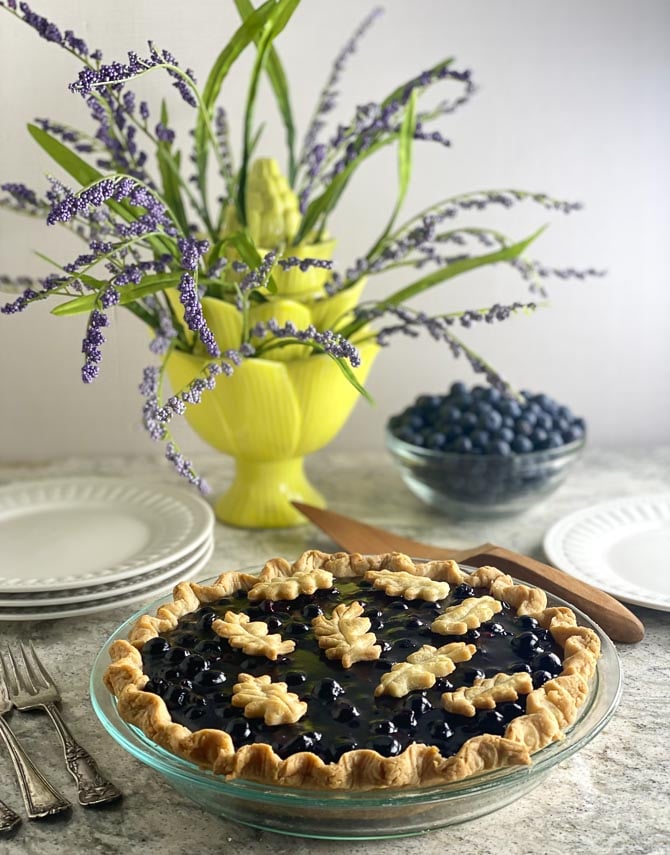
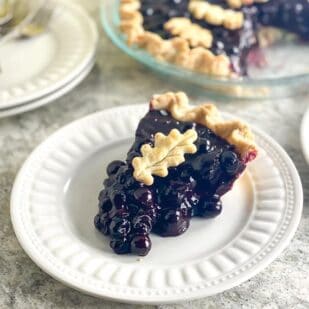
Low FODMAP Fresh Blueberry Pie
What is Low FODMAP Fresh Blueberry Pie? A pie that is so blueberry-y that it is practically incomprehensible. It is made by cooking blueberries on top of the stove until they are jammy, and then folding in fresh blueberries and the whole shebang is poured into a flaky, pre-baked crust.
Ingredients:
- Half Batch Low FODMAP Cream Cheese Crust dough, ready to use
- 3/4 cup (149 g) sugar
- 3 tablespoons cornstarch
- 1/8 teaspoon salt
- ¼ cup (60 ml) cool water
- 5 cups (740 g) fresh blueberries, washed, cleaned, dried, divided
- 1 tablespoon unsalted butter, cut into smaller pieces
- 1 tablespoon fresh squeezed lemon juice
- 1 tablespoon heavy cream; optional and used for leaves
Preparation:
-
Coat a 9-inch (23 cm) ovenproof glass pie plate with nonstick spray.
-
Remove Low FODMAP Cream Cheese Pie Crust dough from refrigerator, unwrap and work it a bit with your hands until pliable. If it is too hard or crumbly, allow it to soften for a few minutes at room temperature.
-
Lightly dust your work surface with low FODMAP gluten-free all-purpose flour and roll out the dough to a diameter of about 12-inches (30.5 cm) around. Fit into the prepared pie plate and flute the edges. Refrigerate the crust for 30 minutes.
-
If you want to make the optional leaves, simply roll out any excess dough, cut with leaf-shaped cookie cutters, and make little veins with the back of a knife. Place on a parchment lined pan, separate from the pie.
-
Position rack in lowest rack of oven for pie. (If also baking leaves, place another rack high up in the oven). Preheat oven to 425°F (220°C). Line pie with foil, parchment or coffee filters and pie weights. Bake for about 20 to 25 minutes or until the crust is beginning to set and color. Remove the pie weights and whatever you used to hold them and continue to bake until crust is fully baked and golden, about 5 minutes longer. Cool on wire rack.
-
For the leaves, bake on high rack along with pie crust. Check then at 5 minutes as they will bake fast. Bake until light golden brown. Cool on rack and save for later.
-
Whisk the sugar, cornstarch and salt together in a non-reactive medium-sized saucepan. Whisk in the water, then fold in 3 cups (444 g) of the blueberries until coated. Cook over medium heat, stirring often, until mixture comes to a boil then adjust heat and vigorously simmer for 2 minutes, stirring frequently. The berries should be thick, glossy and jammy.
-
Remove from heat and immediately stir in the butter until it melts, then stir in the lemon juice and remaining 2 cups (296 g) blueberries until everything is combined well. Scrape into cooled pie shell and allow to cool to room temperature, then refrigerate until firm, about 4 hours. Right before serving place the optional leaves here and there on top. You can serve the pie chilled or at room temperature. I don’t usually serve this pie warm, but Robin ate it warm with vanilla ice cream and said it was fantastic.
Notes:
FODMAP Information
Our recipes are based on Monash University and FODMAP Friendly science.
• Butter: Both Monash University and FODMAP Friendly have lab tested butter. Monash states that a low FODMAP Green Light portion is 1 tablespoon or 19 g and also states that “butter is high in fat and does not contain carbohydrates (FODMAPs)”. FODMAP Friendly gives it a “Pass” at 1 tablespoon or 19 g. Both recommended serving sizes are presented as part of healthy eating guidelines, not as maximum FODMAP serving size. Fat can affect guy motility and trigger IBS symptoms in some people. Eat to your tolerance.
• Blueberries: Blueberries have been lab tested by both Monash University and FODMAP Friendly. FODMAP Friendly gives them a “Pass” at 1 cup or 150 g, with a maximum serve of 3 cups, or 450 g. In initial lab tests, Monash stated that a Green Light low FODMAP serving was a heaping ¼ cup or 40 g. In those initial tests the fruit jumped to Moderate FODMAP levels quickly at ⅓ cup or 50 g (for GOS). Blueberries were re-tested in late 2022 and now are considered low FODMAP at 1 cup or 125 g. Fine print states that they remain low FODMAP up to 500 g, which is the highest amount tested, not necessarily the highest amount that would remain low FODMAP. Eat to your tolerance.
• Lactose-Free Dairy: Lactose-free dairy, such as lactose-free milk or lactose-free cream cheese, has lactase enzyme added that breaks the disaccharide molecules and creates a more digestible dairy product, from a lactose perspective. The resulting product is not dairy-free, but it is lactose-free. Some products might have miniscule amounts of lactose remaining, but the amount is small enough for the product to be labeled as lactose-free. For instance, Breyers Lactose-Free Vanilla Ice Cream states it is 99% lactose-free, while Lactaid Vanilla Ice Cream states it is 100% lactose-free.
• Sugar: Monash University and FODMAP Friendly have both lab tested white, granulated sugar. Monash states that a Green Light low FODMAP serving size of white sugar is ¼ cup (50 g). FODMAP Friendly simply states that they have tested 1 tablespoon and that it is low FODMAP. Regular granulated white sugar is sucrose, which is a disaccharide made up of equal parts glucose and fructose. Sucrose is broken down and absorbed efficiently in the small intestine.
Please always refer to the Monash University & FODMAP Friendly smartphone apps for the most up-to-date lab tested information. As always, your tolerance is what counts; please eat accordingly. The ultimate goal of the low FODMAP diet is to eat as broadly as possible, without triggering symptoms, for the healthiest microbiome.
Nutrition
All nutritional information is based on third-party calculations and should be considered estimates. Actual nutritional content will vary with brands used, measuring methods, portion sizes and more. For a more detailed explanation, please read our article Understanding The Nutrition Panel Within Our Recipes.
